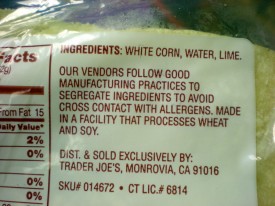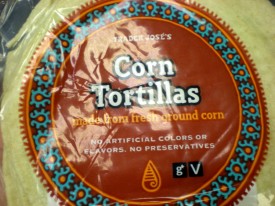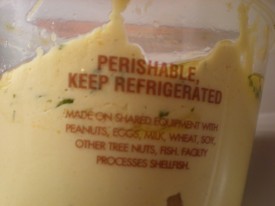
Trader Joe's guide to easier shopping
My first experience of gluten free grocery shopping in Philadelphia was not the greatest. It was my first visit to Trader Joe’s and it didn’t turn out to be what I was hoping for! The huge sign at the front of the supermarket explained the signs to look out for in order to make shopping easier. The ‘g’ symbol which means ‘products in which no ingredients or sub-ingredients contain gluten’ filled me with confidence but this confidence was soon shattered. It appeared I would be able to find lots of gluten free products but this was only true to some extent.
I found corn tortillas which are one of my favourite things these days. They are very flexible and can be eaten at any meal with any filling. Their packaging clearly displayed the ‘g’ I was looking for. I was about to put them in our cart when out of habit I turned the tortillas over to check out the ingredients. I was then faced with a gluten free challenge. Here I was with a product which carried a ‘g’ but which also carried a warning that this product is ‘Made in a facility that processes wheat and soy’ Ok so perhaps Trader Joe’s are just trying to cover their backs? Walmart does the same thing. Almost all of their products, including tinned and frozen veg, include a warning that they were made in a facility that processes wheat. I tend to stay away from these products though.

Confusion on the back

GF corn tortillas?
I became even more confused when I picked up a bag of fresh spinach. This time there was no ‘g’, probably because fresh vegetables are known to be gluten free, but I noticed another warning, similar to the one on the tortillas but slightly more worrying . ‘Made on shared equipment with..wheat..’ I found this on a variety of other products too including hummus (as the photo below shows). What does a coeliac do in a situation like this? Normally products with this warning do not also carry a gluten free symbol! A product made in a factory that processes wheat could perhaps be considered gluten free if precautions are taken and ingredients segregated but can a product made on shared equipment with wheat really be gluten free?

GF signage

Disturbing labelling..
This bizarre signage got me wondering whether I’m being put off by something that is probably the case with all supermarkets but which only certain ones like Trader Joe’s choose to display…
Are most ‘gluten free’ products that we eat manufactured in a factory which produces wheat even if the labelling does not say so? Probably.
Is there a real risk of cross contamination in almost everything we eat unless specifically labelled as being produced in a 100% gluten free facility? I certainly hope not.
UPDATE: Here is the response I got from Trader Joe’s when I emailed them to ask about their ‘No gluten ingredients’ labelling.To me Trader Joe’s gluten free signage is aimed at those with a gluten allergy or non celiac gluten sensitivity rather than for celiacs who cannot risk contamination. Sadly, although Trader Joe’s are trying to help their customers by voluntarily labelling their products as they do, the uncertainties regarding what this labelling actually means puts me off from shopping there. What do you think?
Laura,
Thank you for your inquiry. Products on our No Gluten Ingredients list
may be made on equipment with wheat, and not all products will be listed here or be labeled with this icon.
Our statements are a reaction to a large number of customers that
requested this information on the labels. There are two different
statements because there are two different situations. We felt it was
necessary to differentiate between “shared equipment” and “in a facility
that also processes…” It is a very difficult balance for us to
maintain between the information we provide and the actual health risk
for those that suffer from food allergies.
We are actively trying to separate manufacturing processes for all
products where we can, however, the suppliers for many of our products are not large suppliers, and they do not have the ability to build separate facilities for each item they package or produce, or to build in the necessary barriers in their existing facilities. Our statement
is voluntary, and just because another retailer or manufacturer doesn’t
have similar statements on their packaging doesn’t mean they have
separated their manufacturing processes.
A set of universal dietary guidelines for Celiac Disease does not exist.
Our suppliers follow Good Manufacturing Practices (GMP’s) to segregate
ingredients on shared equipment and/or in the facility. Individuals
have different levels of sensitivity, so remember the motto: When in
doubt, leave it out.




Laurel
Feb 2nd, 2011I have the same dilemma with Trader Joe’s! As a result, I eat pretty much nothing from that store. It could be that they are just more conscientious than other stores in their labeling, but I really don’t know. I’ve come to think of the “no gluten ingredients” designation as something useful for those who are just somewhat gluten intolerant.
For any processed foods, if the equipment is shared with wheat I want to know if they’re doing any testing of gluten levels. Amy’s brand does this, for example.
It’s tough, regardless. Thanks for the post about Trader Joe’s.
Laura
Feb 2nd, 2011Interesting…. I agree that their products and labelling must be more guided towards customers with gluten intolerance. If you have coeliac disease I feel that the risks are too high which is why I stay away from these products.
I will contact the company to see if I can find out whether they test the levels of gluten in their ‘no gluten ingredient’ products!
phil
Feb 11th, 2011I shop at Whole Foods for many GF items. There really not that expensive and carry their own GF baked goods in many stores. Still like Trader Joes (I don’t buy if it says shared equipment) and my local store, but Whole Foods fills the gaps.
Also, Mission corn tortillas are safe –
“Are wheat flour tortillas produced in the same lines as corn products?
No, our corn production lines are dedicated to corn products only. Wheat Flour tortillas are produced in dedicated lines.”
Laura
Feb 14th, 2011Phil, I agree. I’ve opted for Whole Foods. Check out the response I got from TJ’s concerning their gluten free labelling.
Mission tortillas are my favourite. I eat them almost everyday with various fillings.
Sasha
Feb 16th, 2011So does this mean that Whole Foods has a labeling system that means products are both gluten free and produced in factories that don’t put the food in contact with wheat?
This touches on a larger topic that I am noticing about how companies in the U.S. treat the issue of gluten compared to what I noticed in Argentina. In Argentina the level of awareness around celiac seemed much higher and there were products “apto para celiacos” (approved for celiacs) and celiac was treated as a medical condition analagous to diabetes. Here in the U.S. people are aware of the idea of avoiding gluten but people avoid gluten for all kinds of reasons, including just feeling that they will have better health, weight, mood, digestion etc. without gluten. So this leaves me feeling frustrated that there is not enough clarity about celiac and that this is not the same as just avoiding gluten. How did Argentina get such a great consciousness about celiac and how can the same be done in the U.S.? I have a feeling that the level of awareness in Europe is similar to that in the U.S. but not sure.
Laura
Feb 16th, 2011@Sasha, you won’t find products in Whole Foods labelled as ‘without gluten ingredients’ and also labelled as ‘made in a factory that produces wheat’ the way you will in Trader Joe’s but this doesn’t mean it’s not the case and they are just not disclosing it. I’m actually heading to a gluten free event at the Whole Foods in Philly next week so I hope to find out more then..
I think the awareness of celiac in Argentina was due to the labelling law that was just passed in December 2009 but to be honest it was really only Buenos Aires that was so celiac friendly. I could find some of the same gluten free products throughout Patagonia etc but not everything and there were rarely any gf bakeries/restaurants/cafes like in the capital. Hopefully as the labelling law takes hold, so will awareness and options for celiacs and gf travellers around the whole country.
It feels as though awareness of celiac is increasing more and more in both the US and the UK. The UK has Coeliac UK which offers a food&drink directory to show celiacs which products made in the UK are safe and recently more and more companies are joining the gluten free game and do gf product lines. In the US I’ve found a large number of restaurants that label gf options on their menu and most supermarkets here have fairly good gf sections. Big cities like NY, Boston, Philly and SF have so many options for celiacs so I wouldn’t say that consciousness is low here.
Barbara
Mar 31st, 2011Here is the response I received from Trader Joe’s asking for more diligence on Gluten Free labeling.
“Trader Joe’s products are not tested to be gluten free. We do sell many no gluten ingredient products, but do not guarantee that they are not made on shared equipment. Trader Joe’s vendors following Good Manufacturing Practices in terms of cross contamination and if there were ever a reason for TJ’s to believe that there could be any trace cross contamination, we would clearly identify it on the package. ”
We have had reactions to many of these “process in or on” facilities also processing wheat. I would highly recommend that you stay away from these.
Laura
Apr 1st, 2011@Barbara, thanks for this. I’m glad I decided to stay away from Trader’s Joe’s products but sadly it also makes me wonder whether the company were just trying to be transparent by having this labelling and are now missing out on many celiac customers as a result of this honesty. Perhaps other companies out there are getting business from coeliacs because they don’t advertise their products as being ‘made on shared equipment’ etc even though this could quite possibly be the case!
Joyce
Apr 10th, 2011It’s all very confusing. I am newly diagnosed and my MD told me to avoid anything that didn’t say “gluten free” on it. I spent most of my day at Trader Joe’s and Whole Foods. I felt good about my purchases at Trader Joe’s because of their labelling but when I got home and looked more carefully, I noticed several of the items I bought there that were “gluten free” were produced on equipment or a facility with wheat. I will have to be more careful in the future!
Laura
Apr 11th, 2011@Joyce. It is really confusing, especially at first, but it gets easier one you figure out which products are safe 🙂
At first I was a little annoyed at Trader Joes’s when like yourself I saw that many of their items are produced on equipment with wheat but I now I realise that they are at least being honest about manufacturing procedures whilst many other companies may not be.
Good luck with finding safe and delicious things to eat and let us know what you discover!
Marilyn
Apr 13th, 2011Hi Laura, excellent website! As a newly diagnosed celiac living in Mexico, a friend brought me 4 bags of TJ’s Ginger Snaps for a present from the US. I used to love them and couldn’t wait to eat them. They tasted so good I ate half the first bag when I opened them. I didn’t feel very good after that but figured it was that I overate the cookies. So, I ate them just a few at a time but did notice I didn’t feel all that good after eating them and started looking at the package and ingredients. Well, that was pretty eye-opening. So, I stopped eating them all together for some time. Last night I ate one cookie. Within 20 minutes I got gassy and bloaty, core of my body felt hot, had upper GI discomfort, and my skin felt prickly as if I had a sunburn. These are my initial reactions to gluten exposure and I totally believe I am getting gluttened by these cookies! Pepto, Ranitidine, and IB lessened the reaction symptoms but I don’t believe this product is safe for celiacs. Thanks so much for your fun and informative blog! Saludos, Marilyn
Laura
Apr 14th, 2011@Marilyn, thank you! That’s sad to hear that the TJ’s Ginger Snaps made you sick. I haven’t tried those specific cookies. Does the packaging say something like ‘made on the same equipment as wheat’? I’m happy that the company are being honest about their production methods but it also makes me angry that they don’t have a specific gluten free area/machinery to ensure products aren’t only ‘free of gluten ingredients’ but also safe for celiacs!!
Crystal
Aug 17th, 2012OMG my 4 year old had a reaction to TJ’s ginger snaps today, at 1st we were questioning it but after reading this I know for sure he did. I am so sad about not being able to trust TJ, they are so much less expensive for me.
Bell
Oct 29th, 2013It’s 2013 and I find myself still getting sick from Trader Joe’s and other sources that use legalistically protected phrases to sell gluten free products. The best thing is to identify companies that not only state “Gluten-Free”, but also ones that will not give you a line of a government agency, such as the DMV.
Companies get gold stars when they say these few things:
1. Gluten-Free
2. Our in house and/or independent test, tests gluten free at standards that far exceed the government standards of 20ppm. The business continues to be diligent in every supplier
3. GIG (Gluten Intolerance Group) approved
4. The owner is a very sensitive Celiac/Gluten Sensitive person.
Bonus: Non-GMO Project and GF together.